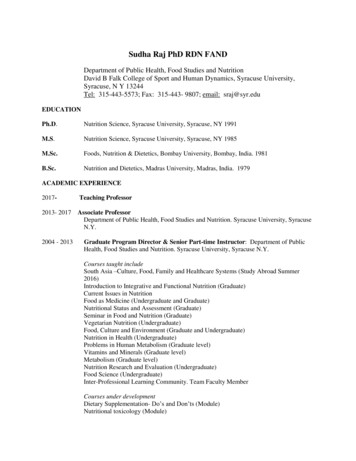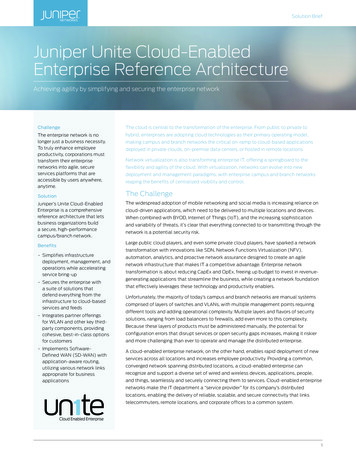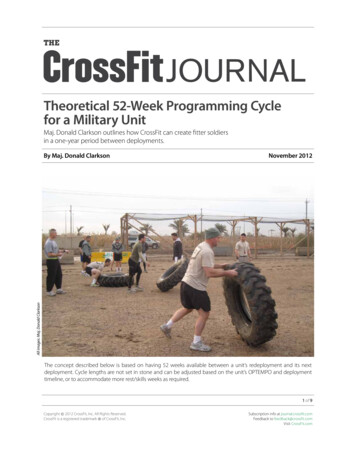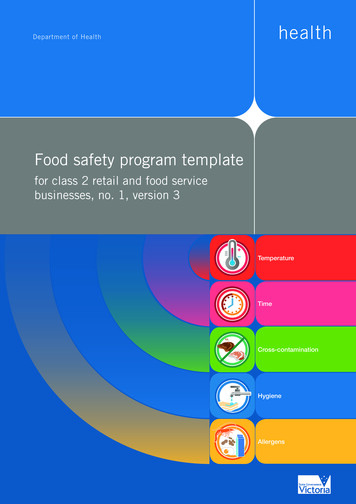
Transcription
FOOD MOVEMENTS UNITE!. . .STRATEGIES TO TRANSFORMOUR FOOD SYSTEMSEDITED BY ERIC HOLT-GIMÉNEZ . FOOD FIRST BOOKSOAKLAND, orgFMU-2.indb 18/16/2011 5:22:44 PM
Copyright (c) 2011 by Food First BooksAll rights reserved. No part of this book may be reproduced or transmitted inany form or by any means, electronic or mechanical, including photocopying,recording, or by any information storage retrieval system, without writtenpermission from the publisher, except for brief reviews.Food First Books, 398 60th Street, Oakland, CA 94618-1212(510) 654-4400 www.foodfirst.orgCover, web, and text design by Richard Jonasse,Birdseye Studio, Oakland, CADevelopment Editor: Patrick KoohafkanCopy Editor: Carrie Laing-PickettProofreader: Martha Katigbak-FernandezLibrary of Congress Cataloging-in-Publication Data:Food movements unite! : strategies to transform our food systems / edited byEric Holt-Giménez.p. cm.\ISBN 978-0-935028-38-6 -- ISBN 978-0-935028-39-31. Food supply. 2. Agricultural productivity. 3. Food industry and trade.4. Food supply--Environmental aspects. 5. Agriculture and state.I. Holt-Gimenez, Eric.HD9000.5.F5954 2011338.1'9--dc232011033220Food Movements Unite! : Strategies to transform ourfood systems / edited by Eric Holt-GiménezFood First Books are distributed by: Perseus Distribution387 Park Ave South, 12th FlrNew York, NY 10016Tel: nted in Canada.FMU-2.indb 28/16/2011 5:22:44 PM
WHY HUNGER: A leader inbuilding the movement to endhunger and poverty by connecting people to nutritious, affordable food and by supportinggrassroots solitions that inspire self-reliance and community empowerment.http://www.whyhunger.org/Roots of Change brings a diverserange of Californians to the tableto build a common interest infood and farming so that everyaspect of our food—from the time it’s grown to the time it’s eaten— can be healthy, safe, profitable, affordable and fair.http://rootsofchange.org/More and Better has been established in 2003 to join and sustainthe fight to eradicate hunger andpoverty. It is an Internationalnetwork embracing social movements, civil society (CSO), non governmental organizations(NGO) and a core of national unified campaigns from all over theworld. http://www.moreandbetter.orgGrassroots International works around theworld to help small farmers and other smallproducers, indigenous peoples and womenwin resource rights: the human rights to land, water and food.http://www.grassrootsonline.orgThe Institute for Food andDevelopment Policy (Food First)is a “people’s think-and-do tank."Our work informs and amplifies the voices of social movementsfighting for food justice and food sovereignty.http://www.foodfirst.orgThe US Food Sovereignty Allianceworks to end poverty, rebuild local food economies, and assertdemocratic control over the foodsystem. We believe people have the right to healthy, culturally appropriate food, produced in an ecologically sound U-2.indb 38/16/2011 5:22:45 PM
AcknowledgmentsThis book would not have been written had it not been for thesupport of the many people who donated their time and expertiseto the project because they believed in the importance of buildinga strong global food movement. Tanya Kerssen helped contactauthors and, along with Marilyn Borchardt, Annie Shattuck, ZoeBrent, and Leonor Hurtado helped with the book’s conception andprovided helpful comments along the way. Bill Wroblewski filmedand edited interviews for the book and the website. Richard Jonassededicated many hours to the book design.We would also like to thank the many generous photographerswho put their wonderful images on Creative Commons, includingthe following, whose work contributed to the cover collages:Meredith Kahn, Schubert Ciencia, SEIU International, AndreasWilkes (Farming Matters), Free Range Jace, Vredeseilanden, GrantNeufield, Jean-Marc Desfilhes, Luciano Garcia, Kasuga Sho, DanielaHartman, Abdulhai A. Al-Abdulhai , International Institute forTropical Agriculture, Bo Nielsen, Jean Marc Desfilhes, Kris Krug,Brennan Cavanaugh, Teemu Mantenen, fuzheado, Internationalcenter for tropical agriculture-CIAT, ImageMD, Swissaid, hey.kiddo, Edible Office, and World Agroforestry Centre.Thanks to Gabriel Holt and Eva Thalia Holt-Rusmore, who spentmany hours painstakingly translating chapters from Spanish andPortuguese into English, as well as Deanna Drake Seeba, whotranslated from French. Thank you Patrick Koohafkan, CarriePickett, and Martha Katigbak for your careful editing. Also thanksto Renee MacKillop, Aja Peterson, Celeste Ariel Peifer, ReemaCherian, Stephanie Kennedy, and Rebecca Mistruzzi, Food Firstinterns who worked on sections of the book.FMU-2.indb 48/16/2011 5:22:45 PM
We also want to especially thank the following benefactors whoresponded to a special appeal and generously donated funds tocover our publishing costs:Joan and Wise Allen, Wayne Alt, Valerie Anderson, CliffordAnderson, Henry Atkins, Jessica Bader, Catherine Badgley, GregoryBartha, Jim Berger, Sid Berkowitz, Scott Bohning, Lorraine Bonner,Nicholas Bridge, George Brieger, Steve Buban, Ingrid Buntschuh,Marie Cadenhead, Gerald Cavanaugh, Lynn Cawthra, Carol andGregory Codner, Bruce Cohen, Mitch Cohen, Dorothy Corbett,Martha Corry, Dr. Monica Courtney, Keith Dangelo, Richard DeWilde, Sylvia Demarest, Maxine and Michael Denniston, Pauland Eleanor Diesing, Uta Dreher, Grace Dumenil, Roger Eberly,Charles Engstrom, Elizabeth Esteves and Saadedine Tebbal, Ronand Bonnie Ettinger, Sabrina and David Falls, Wendy Fassett,Abraham Flaxman, Susan Foerster, Pat Foley, Hunter Francis,Eva Fuld, James and Virginia Gailey, Jan Garrett, LeRoy Gaskin,Audrey Gilmore, Daniel Gladstone, John Gloor, RaymondGoggan, Jean Gore, Margaret Grip, Linda Grove, Victoria HaddWissler, Darcy Hamilton, David and Eleanor Hammer, MargaretHammond, Hildegarde Hannum, Evan Hartman, Gail Hartman,Everett Heath, Louis Hellwig, Narada and Kali Hess, Lois andRon Hines, William Horton, Celeste Howard, Anne Howe, HelenJacobsen, Mary Jean Jawetz, Mark Jay and Karen Pakula, LauraJuraska, David Kaun, Vivienne and Raymond Kell, Elaine Kiharaand David Sweet, Robert and Rita Kimber, Gregory King, Gloriaand F. Ross Kinsler, John Klingman, Kathryn Kram, Kallyn Krashand John Emmanuel, Kathy Labriola and Rick Lewis, MiriamLaster, Eileen and Paul LeFort, Peter Linenthal, David Loeb, BettyLucas, William Lupatkin, Glenn Lyons and Nancy Gerdt, JosephMabel, Locke McCorkle, Sarah Metzger, M. Jane Meyerding, RonMiller, Beth Moore, Lois Moschella, John and Hatsumi Moss, MaryMyers, Abby Nash, David Nelson, Elaine Netherton, Lane Nevares,William Nisbet, Meg Palley, Barbara Parsons, H. F. W. Perk,Linda Peterson, James Reilly, Barbara and Brian Robinson, PeterRobrish, Kathryn Rodriguez, Lorraine Rogers, Gordon Rogoff,FMU-2.indb 58/16/2011 5:22:45 PM
Norma Rossel, Mary Rowe, Dan Ruesnik, Rachel and Joel Samoff,Janis Sarles, Ruth Schultz, Elizabeth Schwerer, Corinne and DavidScott, Dan Seligson, William Sewell, Peter and Elizabeth Shepherd,John Simmons, Tony Stern, Caryl and Milton Stone, Shirley andHarold Strom, Heather Sullivan-Catlin, Barb Swanson, DanielSzyld, Bahram Tavakolian, Eugene Teselle, Murray Tobak, JosephTowle, Richard and Cathleen Vaught, Erika Voss, Victor Wallis,Jane Wentworth, Thurman Wenzl, John and Carolyn White, SharonWhitmore, Patricia and Thomas Willis, Jane Wood, Helen Yost,Barbara Young, Lawrence Young, Robert Zevin, and Charles Zug.Finally, we are profoundly grateful to the hundreds of thousandsof youth, women, and men—the advocates and practitioners ofthe food justice and food sovereignty movements—who are on thefront lines in the struggle to transform our food systems. They arethe inspiration for this book. For them, giving up hope is not anoption.FMU-2.indb 68/16/2011 5:22:45 PM
Table of ContentsPreface:Food Sovereignty:A Struggle for convergence in diversity.Samir Amin ixIntroduction: Strategies to Transform our Food Systems.Eric Holt-Giménez 1PART ONE: FARMERS, SUSTAINABILITY ANDFOOD SOVEREIGNTY1. Food Sovereignty: Alliances and Transformation.Paul Nicholson 92. People Need Food Sovereignty.João Pedro Stédile and Horácio Martins de Carvalho213. Without Clarity on Parity, All You Get Is Charity.George Naylor 354. Rural Women Create Thriving Food Systemsin West Africa.Tabara Ndiaye and Mariamé Ouattara535. Irrepressibly Toward Food Sovereignty.John Wilson 716. Transforming NGO Roles to Help MakeFood Sovereignty a Reality.Fatou Batta, Steve Brescia, Peter Gubbels, Bern Guri,Cantave Jean-Baptiste, and Steve Sherwood ofGroundswell International 93PART TWO: CONSUMERS, LABOR AND FOOD JUSTICE7. Survival Pending Revolution: What the BlackPanthers Can Teach the US Food Movement.Raj Patel 115FMU-2.indb 78/16/2011 5:22:45 PM
8. Beyond Voting With Your Fork: From EnlightenedEating to Movement Building.Josh Viertel 1379. Racism and Food Justice: The Case of Oakland.Brahm Ahmadi 14910. Consciousness Commitment Change.Lucas Benítez 16311. The Restaurant Opportunties Center.José Oliva 17312. We Eat, We Decide.Xavier Montagut 18713. Local Food are Key to Local Economic Recovery.Ken Meter 201PART THREE: DEVELOPMENTCLIMATE AND RIGHTS14. The Transformative Potential of Agroecology.Olivier De Schutter 22315. Agriculture at a Crossroads.Hans R. Herren and Angela Hilmi24316. Now’s the Time to Make it Happen: The UN’sCommittee on Food Security.Nora McKeon 25717. Food Sovereignty and Climate Justice.Brian Tokar 27518. Women's Autonomy and Food Sovereignty.Miriam Nobre 29319. Transforming our Food System byTransforming our Movement.Rosalinda Guillén307Synopsis: Food Movements Unite:Making a New Food System Possible.Eric Holt-Giménez and Annie Shattuck 315FMU-2.indb 88/16/2011 5:22:45 PM
About the Authors 325Resources 327Acronyms 336Glossary 338More Books from Food First344BOXES:CH 1 Sustainable Peasant and Family FarmAgriculture Can Feed the World.La Via Campesina 14CH 2 Land Sovereignty.Jun Borras and Jennifer Franco(Journal of Peasant Studies)29CH 5 African Food Sovereignty.Diamantino Nnampossa(UNAC/La Via Campesina)80CH 7 Youth and Food Justice:Lessons from the Civil Rights Movement.Anim Steel (Boston Food Project)120CH 8 Can activists keep the Fairtrade Market fromUndermining the movement that made it?Christopher M. Bacon, Ph.D. Santa ClaraUniversity 140CH 10 NAFTA Flu.David Bacon 166FMU-2.indb 9CH 14 The Right to Food as a North/SouthConvergence Strategy: US Experience.Molly Anderson (College of the Atlantic)224CH 18 Without Women There is no Food Sovereignty.Esther Vivas (Centro de Estudios sobreMovimientos Sociales; CEMS)3008/16/2011 5:22:45 PM
FMU-2.indb 1148/16/2011 5:22:50 PM
Chapter SevenSURVIVAL PENDING REVOLUTION:WHAT THE BLACK PANTHERS CAN TEACHTHE U.S. FOOD MOVEMENT1By Raj PatelOVER THE PAST DECADE, the US food movement has grownto become a potent force for social change and, precisely becauseof its success, the movement now is being called to shore up thestatus quo. Revisiting some radical roots suggests ways that thefood movement can end hunger in America, rather than becomingjust another impermanent band-aid for poverty.Critical thinking about and organizing around food in the UnitedStates aren’t new— Frances Moore Lappé’s work gave rise tothe institute publishing this book, Food First, nearly 40 years ago(Lappe 1971; Lappé and Collins 1977). Food scares and diet fadsshaped US public consciousness about food through the 1980s and’90s. But I suspect it’s no accident that the movement grew afterthe terrorist attacks of September 11, 2001. As Michael Pollan(2010) notes in his piece “Food Movement Rising” in the New YorkReview of Books:[It] makes sense that food and farming should become alocus of attention for Americans disenchanted with consumercapitalism. Food is the place in daily life where corporatizationcan be most vividly felt: think about the homogenization oftaste and experience represented by fast food. By the sametoken, food offers us one of the shortest, most appealing pathsout of the corporate labyrinth, and into the sheer diversity oflocal flavors, varieties, and characters on offer at the farmers’market.1.I’ve been schooled by many people in the writing of this paper, most of all byKiilu Nyasha, Michael William Doyle, Gayatri Menon, and Eric Holt-Giménez.FMU-2.indb 1158/16/2011 5:22:50 PM
PART TWO: CONSUMERS, LABOR AND FOOD JUSTICE116To be sure, a food movement predated 9/11—the National FamilyFarm Coalition was founded in 1986; environmentalists had beentaking on Monsanto, spurred by Rachel Carson’s 1962 Silent Spring;and the history of American disenchantment with capitalism is asold as the nation itself (Zinn 2003). The American Revolutionwouldn’t have happened but for the actions of merchants protestingthe terms of trade for tea. (Schlesinger 1917). Yet it was only withthe criminalization of dissent, with the increased difficulty ofconfronting corporate capitalism through other politics, and withthe fear coursing through the veins of the US public after 2001 thatthe movement’s strands were more tightly woven together. Underthe Bush regime, environmentalists, social justice campaigners,anticapitalists, and organic foodies found a government, media, andgeneral public far less responsive than a decade before. Membershipof umbrella groups like the Community Food Security Coalitionhas swelled, with a proliferation of food organizations, consultants,academics, and activist groups throughout the US. Under thesecircumstances, a new generation of activists was drawn into themovement. What is particularly striking—and although I haven’tanything but anecdotal evidence to offer in support of this view,I’d be happy to bet—is the relative youth of those moving intothe movement. He may blush, but Josh Viertel—president of SlowFood USA and contributor to this volume—is in his early 30s, andthat’s not an accident. He’s a prodigious leader in a new generationof activists like Oakland’s Brahm Ahmadi and Nikki Henderson,who have organized and advanced food justice in the US during thefirst decade of the 21st century.Part of the success of the movement has been its largelynondenominational, big-tent approach, committed to the idea thatfood should be a pleasure available to all, and that, above all, foodis a domain in which something can and ought swiftly to be done.2Indeed, it’s the very success in community farms, gardens, feeding2.In part, this vision has roots that can be traced to the outsized anarcho-Marxistorganizing that produced Slow Food (Andrews 2008). See also Pew ResearchCenter (2010).FMU-2.indb 1168/16/2011 5:22:50 PM
117WHAT THE BLACK PANTHERS CAN TEACH THE U.S. FOOD MOVEMENTprograms, kitchens, and food banks that has helped recruit more andmore people to a movement that seems to offer the transcendenceof “old politics” so earnestly cashed in by the Obama campaign inits first election run.Yet it’s the movement’s practical success that puts it in a precariousposition today. At the time of this writing, hunger is its highest levelsin a generation (Nord et al. 2010)—50.2 million Americans arefood insecure, and one-third of female-headed households are foodinsecure. At the same time, food prices are rising, unemploymentremains stubbornly high, and a Republican Congress has ambitionsto amputate social programs from the body of government in thename of fighting inflation (Patel 2011). In the resulting vacuum,community organizations have been pressed, much to government’sapproval, into the business of service provision. As Suzi Leatherremarked of a similar period in the UK government’s history:It is easy to see the appeal of the community developmentapproach for the present administration: it smacks of the selfhelp ethos, involves vanishingly small resources and can beencouraged without at the same time having to admit to theexistence of poverty. (Leather 1996, 47–48)To inoculate ourselves against the dangers of being co-opted intothe very food system we have spent a decade criticizing, we needpolitics. Two instant caveats, though. First, merely talking aboutthe politics of the modern food system isn’t sufficient to preventthe movement’s energy from being dissipated while dealing withthe “dignified emergency”3 of increasing hunger. History is litteredwith all-night activist conversations about the root causes ofhunger, with little change to believe in the morning after. Second,a call to talk about capitalism in the food system isn’t a call for asingle totalitarian politics to which all must subscribe. Every USsocial movement, from abolition to the Tea Party, has drawn on anassortment of sometimes contradictory political positions.3.This is a phrase I have learned, and embrace, from Nick Saul’s work at The Stop.For an example of how this thinking informs community organizing in dignifiedemergency here, see Scharf, Levkoe, and Saul (2010).FMU-2.indb 1178/16/2011 5:22:50 PM
PART TWO: CONSUMERS, LABOR AND FOOD JUSTICE118The problem is that the food movement’s ideological pantry israrely raided, and despite a rich history, there’s not nearly enoughtalk about it. By food politics, I don’t just mean the kinds ofinteraction between state and private sector presented by MarionNestle in her fine dissection of the food industrial complex (Nestle2002). I’m referring to politics as an ideology, as a positive systemof beliefs, analytical principles, and values that informs practice(Badiou 2005; Hall 1996; Rancière 2007). And of these systemsof politics, there seems insufficient praxis. Perhaps the origins ofthe food movement, in politically embattled times, is to blame fora certain ideological quietism. But whatever the food movement’sgenealogy, its future needn’t be hostage to the past.Activist Anim Steele’s (2010) work, drawing on the civil rightsmovement, dips into movement history a little, but it’s worthremembering that the civil rights movement itself was hardlyhomogenous. Its demands for political and civic rights were nestedin further demands for economic and social rights—a recognitionthat Martin Luther King (1967) himself made explicit toward theend of his life:One day we must ask the question, “Why are there fortymillion poor people in America?” And when you begin to askthat question, you are raising questions about the economicsystem, about a broader distribution of wealth. When you askthat question, you begin to question the capitalistic economy.And I’m simply saying that more and more, we’ve got to beginto ask questions about the whole society. We are called upon tohelp the discouraged beggars in life’s market place. But one daywe must come to see that an edifice which produces beggarsneeds restructuring. It means that questions must be raised. Yousee, my friends, when you deal with this, you begin to ask thequestion, “Who owns the oil?” You begin to ask the question,“Who owns the iron ore?” You begin to ask the question, “Whyis it that people have to pay water bills in a world that is twothirds water?” These are questions that must be asked.FMU-2.indb 1188/16/2011 5:22:50 PM
119WHAT THE BLACK PANTHERS CAN TEACH THE U.S. FOOD MOVEMENTKing moved through a wide field of politics, in which talk aboutthe failures of capitalism was part of popular discourse, and whichKing himself began to embrace more fully toward the end ofthis life. Certainly, the civil rights movement addressed issues ofhunger. The day after King’s assassination, the NAACP subverteda USDA press conference at the USDA, announcing their intentionto sue the government for its failure to bring school lunches intocompliance with civil rights legislation (Levine 2008, 136). Butit’s another movement from which I’d like to learn, one that boththrived and was destroyed because it addressed issues around food,and that offers something surprising and powerful for our politicalimaginations today.The Black Panthers Feed the WorldAlthough poverty had been worse in the late 1960s, and althoughpoverty would worsen again, African Americans were asdisproportionately represented among the hungry as they hadever been. One of the constants of post–World War II US lifehas been that African American income has consistently stayedat around 60% of white household income (DeNavas-Walt,Proctor, and Smith 2009). The federal government’s persistentrefusal to address poverty in African American communities wascompounded in the 1960s by an ongoing criminalization of poor,urban African Americans by local and state police, with attendantand systematic police violence against black men. It was theencounter with this “police logic” that spurred two students atMerritt College in Oakland, Huey Newton and Bobby Seale, tolaunch the Black Panther Party for Self Defense—later shortenedto the Blank Panther Party (BPP) (Cleaver and Katsiaficas 2001;Hilliard and Cole 1993; Rancière 1998; Seale 1970; Singh 1998).The party initially organized and armed themselves to monitor theOakland police in December 1966, opening their office in Oaklandin January 1967 (Seale 1970).The party soon expanded its ambit beyond police surveillance,dropping “for Self Defense” from its name and, through dialogueFMU-2.indb 1198/16/2011 5:22:50 PM
PART TWO: CONSUMERS, LABOR AND FOOD JUSTICE120with community members, setting up a range of community serviceprograms. By 1968, the most successful of these, the Breakfast forChildren Program, was up and running in the Bay Area and Seattle(Abron 1998; Newton, Hilliard, and Weise 2002, 15).Youth and Food Justice:Lessons from the Civil Rights MovementBy Anim SteelImproving the health of our youth will require a transformation of ourfood system. This in turn will require strong social movements capable ofcreating the political will to truly transform how we grow, buy, prepare, andeat food. Lessons from the civil rights era of the 1960s suggest a way thattoday’s food justice movement can organize. In particular, a new, youthled, multiracial coalition could unleash the voice and energy of those withthe most to gain from transforming the food system—young people.The political disenfranchisement addressed by the civil rights movementin the 1960s, and the cheap, unhealthy food plaguing our underservedcommunities both reflect structural inequities that marginalize people ofcolor. We can’t change the food system by simply changing the tastes andattitudes of regular people any more than the civil rights movement couldend segregation without the 1964 Civil Rights Act. Beyond the personal,these transformations require political, economic, and cultural changes.Just as with the civil rights movement, transformation needs to be local,national, and international. Social movements will play a deciding role increating the political will for change just as they did with civil rights.To become a strong national force, the food justice movement needs ayouth-led organization that unifies and amplifies these disparate efforts—amodern-day food justice version of the Student Nonviolent CoordinatingCampaign (SNCC). Such an organization should celebrate and encouragethe diversity of local work; the best local solutions come from localcommunities. But it should do what local organizations often have a hardertime doing: focus the national spotlight, spread innovation, involve massesof people, and harness our collective political and economic power. Such anorganization should prioritize the voices of those most hurt by the system,even as it welcomes the contributions of all who care.Youth Food Movements Unite!Full Article at: U-2.indb 1208/16/2011 5:22:50 PM
121WHAT THE BLACK PANTHERS CAN TEACH THE U.S. FOOD MOVEMENTThe origins of the program aren’t clear. In some Panther writings,it appears as an endogenously chosen, natural outcome of acommitment to “serve the people” (Seale 1970). Bobby Sealealso suggested that he arrived at the idea through conversationswith local teachers, and needed to persuade Eldridge Cleaver, thePanther’s minister for information, who thought that free breakfastswere a “sissy program,” but was eventually won over (Rhodes2007, 251).This isn’t the breakfast program’s only creation story, though. In hismemoir, David Hilliard, the Panther’s chief of staff (Hilliard andCole 1993), recalls a donation of food given by Emmett Grogan, anactivist with the Diggers in San Francisco (Grogan 2008, 475). TheDiggers, a breakaway group from the San Francisco Mime Troupeperforming arts group, traced their name and, in part, their politics tothe 17th-century movement resisting enclosure in England (Gurney1994). The original Diggers were stout defenders of communitarianproperty and collective self-government of agricultural land. Themodern Diggers blended situationist4 performance with theirpredecessors’ agrarian communism through “events” like givingaway free food. Grogan describes how the free-food giveawaysin San Francisco’s Panhandle district involved stepping through abright-orange window frame called the Free Frame of Reference,so that when the hungry emerged on the other side, their frame ofreference had been changed (Grogan 2008, 250). Note, incidentally,that after an initial attempt at cooking the food himself, Groganpassed on responsibility for doing it to “a half-dozen young women,a few of whom were dropouts from Antioch College, shared a largepad together on Clayton Street and volunteered to take over thecooking indefinitely” (248).No matter who did the cooking, it’s clear that these events were awell-publicized part of the 1960s Bay Area counterculture, and it’s4.Situationism offers a critique of the mass media under capitalism. The Frenchintellectual Guy Debord wrote situationism’s classic book, The Society of theSpectacle (2002), in which he argued that “[a]ll that was once directly lived hasbecome mere representation.”FMU-2.indb 1218/16/2011 5:22:50 PM
PART TWO: CONSUMERS, LABOR AND FOOD JUSTICE122more likely that the Panthers knew of them than not (Doyle 2011).Grogan writes of a meeting following the 1968 killing of BlackPanther activist Bobby Hutton, in which Grogan, together with“Black Panther Party Chairman Bobby Seale, and Chief of StaffDavid Hilliard . . . began discussing a plan they had to start a FreeBreakfast for Children program that would put some nourishmentinto the normally empty bellies of black kids before they went toschool” (Grogan 2008, 474–75). It’d be tempting to chalk thistale to Grogan’s literary bravura—his autobiography often playsfast and loose with the truth—but David Hilliard’s discussion ofGrogan corroborates some of the facts, and is worth quoting atlength:Emmett Grogan sticks his head in the office. Emmett is thefounder of the Diggers, a tribe—that’s what some radicals calltheir groups—who organize the “street people” of the Haightinto revolutionary activity. A few weeks ago, Emmett left offsome bags of food his group distributes to the runaways, draftresisters and freaks who have flocked to Berkeley, turning thetown into the nation’s counterculture capital. We told him toput the stuff outside the office: in a few minutes people wereflocking by, stocking up on onions and potatoes. Now Emmettdonates the food regularly. Like the newspaper, the food servesa double purpose, providing sustenance but also functioningas an organizing tool: people enter the office when they comeby, take some leaflets, sit in on an elementary PE [politicaleducation] class, talk to cadre, and exchange ideas, all part ofthe revolutionary ferment I have imagined when listening toHuey describe Fidel and Che in Cuba. (Hilliard and Cole 1993,158)What’s nice about this story is, first, the piercing of racialboundaries traditionally associated with the Panthers. It turns outthat—surprise!—there were interactions between different radicalgroups within the Bay Area, and that they learned from one another.What’s also nice about it is the ability to trace the genealogy of theFMU-2.indb 1228/16/2011 5:22:50 PM
123WHAT THE BLACK PANTHERS CAN TEACH THE U.S. FOOD MOVEMENTfree breakfast programs back to radical movements to defend thecommons. Finally, of course, what matters here is not just that thefood was distributed—even the federal government was doing that,very poorly, as part of the school breakfast program in the 1966Child Nutrition Act. What distinguished the Black Panther Party’sfood distribution was its part in a far wider vision for social change.Part of the mechanisms of the Black Panther Party’s self-defensewere programs for survival, ranging from the provision of freeshoes and education to land banking and the school breakfastprogram (Huey P. Newton Foundation and Hilliard 2008). In theprovision of these services, Newton understood the ambiguitiesand contradictions within the programs:All these programs satisfy the deep needs of the community but theyare not solutions to our problems. That is why we call them survivalprograms, meaning survival pending revolution. We say that thesurvival program of the Black Panther Party is like the survivalkit of a sailor stranded on a raft. It helps him to sustain himselfuntil he can get completely out of that situation. So the survivalprograms are not answers or solutions, but they will help us toorganize the community around a true analysis and understandingof their situation. When consciousness and understanding is raisedto a high level then the community will seize the time and deliverthemselves from the boot of their oppressors. (Huey P. NewtonFoundation and Hilliard 2008, 4)The breakfast program itself served a shifting menu, with varyingdegrees of success, numbers served, and outreach in the 45 differentbranches nationwide.5 New York’s chapters fed numbers in thehundreds, California
4. Food supply--Environmental aspects. 5. Agriculture and state. I. Holt-Gimenez, Eric. HD9000.5.F5954 2011 338.1'9--dc232011033220 Food Movements Unite! : Strategies to transform our food systems / edited by Eric Holt-Giménez Food First Books are distributed by: Perseus Distribution 387 Park Ave South, 12th Flr New York, NY 10016 Tel: 212-340 .










